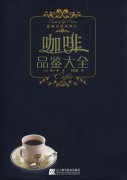The master will fight! How to taste a coffee from shallow to deep?

For professional baristas, please follow the coffee workshop (Wechat official account cafe_style)
Just came into contact with the "coffee flavor table" in the eyes of Hu Coffee Xiaobai, perhaps the most intuitive feeling is like this:
The most correct
SCAA Flavor Wheel should be interpreted in this way:
I believe that friends who love high-quality coffee will be no stranger to the coffee flavor wheel. As a tool, whether in professional cup testing or daily coffee tasting, it is very intuitive, easy to use, and can be easily used to analyze and describe coffee.
When many coffee lovers first come into contact with individual coffee, they will have the following questions:
I like a certain flavor of coffee, but why can't I drink the flavor described on the coffee bean package?
How can I find these flavors in the coffee?
In fact, the answers to these questions can be found in the flavor wheel. Most of the time, our sense of taste and aroma memory, when used, is too little. This cup of coffee awakens the touch of that taste, but you can't remember it. At this time, the flavor spectrum included in the flavor round may help you. Guide you like a mentor and bring you back to that memory.
Today, we take the candle in the popular 90 + lever up series as an example:
Drima Zede candle
Product name: Drima Zede candle
Origin: Sidamo, Ethiopia
Altitude: 1750-2000
Treatment: insolation
With the help of the new flavor wheel of SCAA, we will lead you to taste this coffee from shallow to deep. We can simply divide the process of tasting coffee into four steps: smelling, sucking, identifying, and describing. You can apply this method to any kind of beans you have, and you may be able to discover coffee flavors that you have inadvertently ignored before.
1. Smell
The flavor of coffee is numerous and complicated. Smelling this step is extremely important, because our nose can recognize thousands of flavors, and compared with mouths that can only distinguish sour, sweet, bitter, salty and fresh tastes, our nose is really the best assistant for us to taste and appreciate coffee. When we get a cup of candle, we can clearly smell the flower and fruit aroma of the candle.
Photo: Wang Li Coffee experience Center
Then what kind of flower is more similar to its fragrance? Which kind of fruit is more similar to its fruit aroma? Is it berries, oranges, or other fruits? Next, explore the outer circle of Flavor Wheel!
Photo: Wang Li Coffee experience Center
Carefully, you may have noticed that the gap between each flavor varies in size.
Photo: Wang Li Coffee experience Center
These represent their similarity, the smaller the gap, the more similar the two flavors; the larger the gap, the greater the flavor difference. Re-smell this cup of coffee, with the help of this rule of the flavor wheel, we can more accurately and more clearly judge that the candle has the smell of orange or grapefruit, rather than lime.
If you have some experience in tasting coffee, you may be able to smell some caramel, honey-like round and full sweetness.
Photo: Wang Li Coffee experience Center
2. Suck vigorously
The purpose of vigorously sucking coffee is to atomize the coffee as soon as it enters the mouth, filling the entire mouth and even connecting the upper jaw of the nasal cavity, which helps us to find a deeper flavor in the coffee. In the process of tasting, we can still borrow the flavor theory and gradually explore the deeper flavor of candles, which will be an interesting process.
When we taste coffee, the sense of taste we perceive is different from the smell we smelled before. For example, as we have smelled before, the aroma of citrus fruit is closer to that of orange peel, while now it tastes more like mango.
In addition, we can also appreciate it from the taste of the candle. It has the mellow and silky touch of cream chocolate, with the smell of lychee. The last point of tasting is Huigan. The so-called Huigan refers to the aftertaste of coffee in the mouth and throat.
3. Confirm
When we determine the flavor of coffee, the most powerful basis is from the flavor described on the coffee beans. At this time, we have to go back to describe the flavor here and read it carefully.
[Drima Zede candle] compared with ordinary sun-treated beans, the flavor is cleaner and brighter, with medium mellow thickness, tropical fruits in the front, with a slight sense of fermentation, litchi and mango in the middle, and brown sugar at the end.
Because our visual senses are very effective in connecting our other senses, just as we imagine the taste of food in our minds when we see it. For example, when we smell the delicate fragrance of candles, we think of pink flowers; when we taste the flavor of citrus fruits, we think of "orange" fruits. One of the conveniences of the flavor wheel is also reflected here, we can quickly find the location of the flavor in the picture through the imagined color, helping us quickly locate the fleeting charming aroma, so that they have nowhere to hide.
4. Communication
The most important thing is to communicate when tasting coffee! Although most of the words of Flavor Wheel are easy to understand, we do not recommend sticking to the above words too much. Why don't we describe the information we taste in our own language?
So, if possible, it's best to try several different coffees at a time. The advantage of this is that you can deepen your feelings about the different flavors of various coffees through comparison and train your taste buds. All samples are treated the same so that there is comparability between samples. Calm down and enjoy the process. The more experience you taste, the more acutely you feel the taste of coffee. If you want to refine your sense of taste, you can start from this, that is: taste, taste, taste.
Photo Source: Tamo Coffee
How to train your tongue?
The process of training your tongue is not complicated. You only need enough patience and as many varieties of coffee as possible to improve your taste. (reference source: CafeCulture forfeiture)
Here are the simple steps to train your tongue:
① buys coffee
Go to a nearby roaster or coffee shop to buy two different kinds of coffee. When buying, ask the roaster or coffee shop owner for information about coffee, and the information they provide will be of great help to your senses.
② small cup of coffee
Buy hanging-ear coffee and make just enough coffee at a time for tasting.
③ brewing coffee
Use two pressure pots to make two kinds of coffee. Using a small pressure pot can minimize the waste of coffee.
④ cools slightly
Although we all like hot coffee, it's best to cool the coffee a little while training our senses, so that the taste of the coffee can be more easily recognized.
⑤ repeated comparison
The two cups of coffee are ready. Now please inhale the coffee, taste it carefully, and compare the taste difference between the two cups of coffee over and over again. Take a few seconds before tasting another cup of coffee. Don't let the taste of the last cup affect your perception of the taste of another cup of coffee.
⑥ thinks about the taste.
Before you start to identify the taste, first distinguish the taste of two cups of coffee, which one is thicker? Which one is purer? Record the taste you feel so that you can better distinguish the characteristics of the two cups of coffee later.
⑦ doesn't have to worry too much about taste.
Although your goal is to train how to identify taste, but since it is only in its infancy, if you encounter an indescribable taste, you don't have to struggle too much. you just need to record the taste you taste, and then summarize and analyze it later. with the deepening of the training, one day you will taste more flavor!
⑧ reference tag
Here I would like to emphasize that do not look at the label before the start of training! You need to train your tongue based on your own feelings, rather than following the advice given by others. But at the end of the training, you need to refer to the label to determine whether your description of taste, taste and mellow thickness is accurate, which will not only help you accumulate more professional vocabulary, but also improve the accuracy of your senses.
So, how often should we train?
I suggest training as much as possible. Training is a slow accumulation process, which can not be achieved overnight, so frequent training will make your tongue more sensitive, make your perception of taste more accurate, and after mastering certain skills, the process of tasting will become very interesting!
Other considerations
① check the nose.
You know, our sense of smell and taste are actually the same. For example, if you have a stuffy nose when you have a cold, you can't taste anything. This is because a cold clogs the nasal passages and makes it difficult for the nose to perceive aroma, so check whether your nose is ventilated before tasting.
② quit smoking
If you are a smoker, I advise you to quit smoking as soon as possible. Cigarettes will greatly affect the sensitivity of your tongue and other senses, but don't worry, even if you have smoked for a long time, quitting smoking will restore your senses to their original level. If you want to taste the subtle taste characteristics of coffee, you have no choice but to quit smoking.
③ learning flavor wheel
The "Coffee Flavor Wheel" developed by the American Fine Coffee Association (SCAA) can help you accurately describe the taste of coffee. As a general industry standard, its authority and accuracy are beyond doubt. I suggest that while training your senses, learn the professional vocabulary in the flavor wheel, which will not only help you deepen your understanding of coffee taste, but also help you avoid misunderstandings in taste identification as much as possible.
Anyone who persists in training can taste the delicate taste of coffee. As long as you practice patiently and accumulate constantly, the door of the coffee world will be open to you. When training your senses, be sure to use high-quality coffee bought from boutique cafes or roasters, and never go astray by using shoddy coffee.
As long as you keep training, you will soon be able to taste the subtle difference between coffee and coffee. With a little effort, your coffee experience will be improved.
From today on, train your tongue while drinking coffee.
Important Notice :
前街咖啡 FrontStreet Coffee has moved to new addredd:
FrontStreet Coffee Address: 315,Donghua East Road,GuangZhou
Tel:020 38364473
- Prev

Practical information | Translation of the Handbook of Professional baristas (3) the strength of pressing powder, how to press powder..
Professional baristas Please pay attention to the Coffee Workshop (Wechat official account cafe_style) there are many people who admire the profession of baristas very much, and some even aspire to become a barista. These ideas are not surprising, because baristas can really taste all the most delicious coffee, and they can also do cool experiments with different drinks and use those super high.
- Next

Practical information | Translation of the Handbook of Professional baristas (2) Espresso grinding, powder filling and cloth powder
Professional barista communication please follow the coffee workshop (Wechat official account cafe_style) the second part of the introduction to professional baristas! Three keys to success when most coffee shop owners hire baristas, the most important thing is not a job seeker who is skilled in brewing coffee. They pay more attention to first impressions, including conversation, appearance and basic knowledge of coffee. When you successfully enter the profession
Related
- Beginners will see the "Coffee pull flower" guide!
- What is the difference between ice blog purified milk and ordinary milk coffee?
- Why is the Philippines the largest producer of crops in Liberia?
- For coffee extraction, should the fine powder be retained?
- How does extracted espresso fill pressed powder? How much strength does it take to press the powder?
- How to make jasmine cold extract coffee? Is the jasmine + latte good?
- Will this little toy really make the coffee taste better? How does Lily Drip affect coffee extraction?
- Will the action of slapping the filter cup also affect coffee extraction?
- What's the difference between powder-to-water ratio and powder-to-liquid ratio?
- What is the Ethiopian local species? What does it have to do with Heirloom native species?

